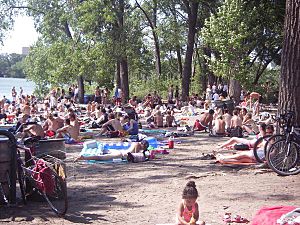Cedar Lake East Beach facts for kids
Quick facts for kids Cedar Lake East Beach |
|
|---|---|

Many people at Cedar Lake Beach, then known as Hidden Beach, in July 2007.
|
|
| Type | Swimming beach |
| Location | Minneapolis, Minnesota, United States |
| Operated by | Minneapolis Park and Recreation Board |
| Open | Daily, 6:00 a.m. to 10:00 p.m. |
| Designation | Life guards on duty seasonally |
| Website | Cedar Lake East Beach |
Cedar Lake East Beach is a popular beach in Minneapolis, Minnesota, United States. It's located on the east side of Cedar Lake. The Minneapolis Park and Recreation Board takes care of it.
This beach used to be called Hidden Beach. It was once hard to find, hidden down a forest path. This made it a special spot in the 1960s and 1970s for people who liked different ways of thinking. Over the years, the beach had some problems and safety worries. Because of this, the park board worked to make it more "family-friendly" in the late 2010s.
Contents
Beach History: A Look Back
Railroads and Land Changes: 1860s to 1980s
Cedar Lake looked very different before 1867. Many areas around Cedar Lake East Beach were once water and wetlands. In 1867, a railway company built a raised path, called a causeway, through a large bay on the east side of the lake. Another railroad joined them in 1871, adding more tracks.
Over time, they filled in the bay east of the causeway with dirt and other materials. This new land was used to create a big train yard. In 1878, a large company started cutting ice from the lake. They shipped this ice to places far away, like St. Louis, Missouri. By 1900, a boat house was at the end of a thin piece of land on the lake's eastern side. This land eventually grew wider and became the spot for Cedar Lake East Beach.
In 1913, Cedar Lake's water level was lowered by 5 feet (1.5 m). This was done to connect it with Lake of the Isles. It was part of a bigger plan to create the Chain of Lakes and the Grand Rounds Scenic Byway. When the lake level dropped, the part of the bay west of the old railway path completely dried up.
Even with all the train activity nearby, land around Cedar Lake's eastern shore was sold. Between 1895 and 1975, houses and hotels were built there. In the 1950s, the area was even used as a city dump. A lot of waste from building interstate highways ended up as piles of trash along the shoreline. These piles soon grew over with cottonwood trees, forming the forested hills you see today.
Hidden Beach Days: 1960s to 1990s
Around the 1960s, the beach started to become well-known. Back then, it was just a small grassy spot by the water. You could only reach it by a narrow trail, like a deer path. Most of the train yard closed by the mid-1980s. The old tracks and buildings were removed. In 1988, people living nearby bought the land between the lake and the road. They turned it into a city park, hoping to create a nature park.
Making it a Park: 1990s to 2010s
In 1995, local residents used special funds to hire police officers. These officers would patrol the beach more often. Some people thought that not having a clear entrance made it hard for police to get to the beach. Others felt that wealthy neighbors wanted to stop people from outside the area from using the beach.
There was also a big concern about an invasive plant called Buckthorn. This plant had taken over more than 70% of the park. In 2002, the park board decided to fix up the park. They wanted to address both safety and the plant problem. That summer, they made the paths to the beach wider by removing buckthorn and some other trees. They continued to remove more plants in the following years.
In 2007, community members met to talk about the beach. Neighbors voted against building a large parking lot. However, they did vote to put gravel on the path to the beach. This meant removing more trees, but it allowed service and police vehicles to reach the area. Other improvements approved included adding picnic tables, a grill, and a lifeguard stand. The first wooden lifeguard stand was damaged and was later replaced with a metal one.
Photo gallery






